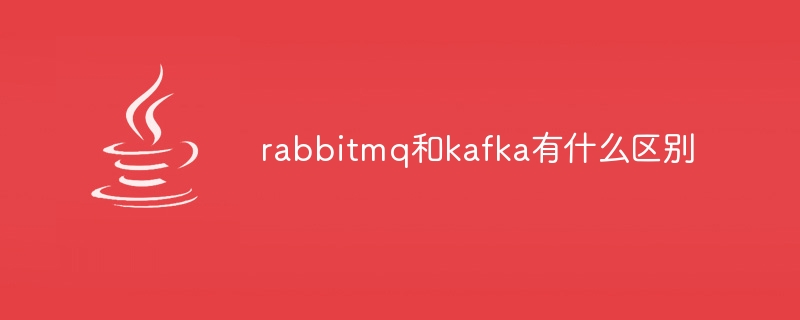The difference between rabbitmq and kafka: 1. Language and platform; 2. Message passing model; 3. Reliability; 4. Performance and throughput; 5. Cluster and load balancing; 6. Consumption model; 7. Purposes and scenarios; 8. Community and ecosystem; 9. Monitoring and management; 10. Other characteristics. Detailed introduction: 1. Language and platform. RabbitMQ is developed by Erlang language and is mainly used to transmit real-time messages between systems that require reliable message delivery. Kafka is developed by Scala language and so on.

The operating system for this tutorial: Windows 10 system, DELL G3 computer.
RabbitMQ and Kafka are two widely used message queue systems, and they have some key differences in design and use. The following is a detailed analysis of the difference between RabbitMQ and Kafka:
1. Language and platform:
- RabbitMQ: It is developed by the Erlang language and is mainly used Used for delivering real-time messages between systems that require reliable messaging. Erlang is a concurrency-oriented programming language that is particularly suitable for building distributed and fault-tolerant systems.
- Kafka: It is developed by the Scala language and is mainly used to handle active streaming data and large-volume data processing. Scala is also a concurrency-oriented language and is compatible with Java, which allows Kafka to run in a Java environment.
2. Message passing model:
- RabbitMQ: It uses AMQP (Advanced Message Queuing Protocol), which is a dedicated asynchronous messaging model Designed network protocols. RabbitMQ's broker consists of Exchange, Binding, Queue and other components.
- Kafka: It adopts a publish/subscribe model, in which message producers publish messages to specific topics, and consumers subscribe to these topics to obtain messages. The broker in Kafka consists of partitions.
3. Reliability:
- RabbitMQ: It provides a high level of reliability, including message persistence, transaction support and message confirmation mechanism. This means that even if the service crashes or is restarted, messages are not lost and clients can be sure that messages have been processed correctly when processing them.
- Kafka: It does not provide transaction support, but guarantees throughput by storing messages in partitions and allowing consumers to read data from these partitions. However, it may experience duplicate or lost messages, especially under high load.
4. Performance and throughput:
- RabbitMQ: Although it may encounter performance problems when processing large amounts of data, due to its Message persistence and reliable transmission mechanism, it is usually used in scenarios that require reliable message delivery, such as financial transactions or event notifications.
- Kafka: Due to its stream processing method and high-performance design, Kafka is able to handle larger amounts of data. It is commonly used in scenarios such as big data processing, real-time stream analysis, and log aggregation. Kafka can handle highly concurrent messages and has higher throughput.
5. Clustering and load balancing:
- RabbitMQ: It does not support load balancing itself and needs the help of an external load balancer. Balancing and failover of services. This may increase the complexity of the system.
- Kafka: Kafka’s cluster design enables automatic load balancing. Topic partitions can be automatically redistributed even when brokers are added or removed from the cluster.
6. Consumption model:
- RabbitMQ: It uses the push method, that is, the consumer actively pulls messages from the broker. This approach allows consumers to have more fine-grained control over the messages they pull.
- Kafka: It uses the pull method, that is, the consumer pulls data from the broker. This approach allows Kafka to better control the consumption speed and prevent data loss caused by consumers consuming too quickly.
7. Uses and scenarios:
- RabbitMQ: Due to its high reliability and real-time nature, it is often used in scenarios that require real-time and reliable messaging, such as financial transactions, event-driven architecture, etc.
- Kafka: Due to its high performance and large capacity characteristics, it is often used in scenarios such as big data processing, real-time stream analysis and log aggregation, especially in scenarios where large amounts of active data need to be processed.
8. Community and Ecosystem:
- RabbitMQ: Due to its long history and mature ecosystem, it is used in many enterprises and projects It has been widely used and recognized. Its community is active and mature, offering a wealth of plugins and integrations.
- Kafka: Although Kafka is relatively new, its rapid growth and widespread adoption have made it one of the standards for stream processing. Its community is large and active, with many companies and open source projects using and contributing to Kafka's ecosystem.
9. Monitoring and management:
- RabbitMQ: Provides a wealth of monitoring and management tools, such as Dashboard, HTTP API and command line tools etc., to facilitate users to view and manage the status and performance indicators of components such as queues, switches, and consumers.
- Kafka: It also provides similar monitoring and management tools, such as command line interface, JMX indicators and Confluent Control Center, etc., which can help users monitor and manage the performance and status of Kafka cluster.
10. Other features:
- RabbitMQ: Provides more advanced features, such as transaction support, message persistence and message confirmation mechanism Etc., these characteristics make it perform well in scenarios that require high reliability and real-time performance.
- Kafka: Due to its stream processing method and large-capacity characteristics, it performs well in big data processing and real-time stream analysis. At the same time, due to its partitioning nature, it is able to handle higher concurrency and has greater scalability.
The above is the detailed content of What is the difference between rabbitmq and kafka. For more information, please follow other related articles on the PHP Chinese website!































![[Web front-end] Node.js quick start](https://img.php.cn/upload/course/000/000/067/662b5d34ba7c0227.png)



